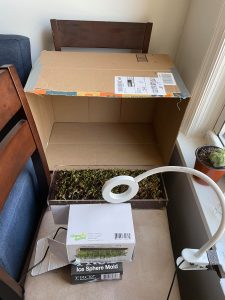This week, we continued to work on our individual components, and we all planted the pea shoots. I tested whether night vision works in complete darkness, and it does so there is no extra LED lights needed in the dark. I’ve decided to turn off some CV analysis once the camera switches to night vision, because without the original colors of the image, we cannot perform proper analysis. Further, the plants grow very gradually day by day and assuming gardeners will be asleep at night, its unnecessary for the constant analysis. I was able to test my pea shoots that already sprouted, and using the pixel per metric method, I was able to classify the pea shoots as sprouting. I will need to adjust the camera and planting tray position to get a perfect sideview of the pea shoots for more accurate plant height calculation. Currently, I am working on making each leaf and flower an object and going through the list of objects to distinguish the difference and determine whether they are healthy, diseased, or withered with some edge detection and another layer of HSV Color Detection.
I am a bit behind schedule, as I wanted to test some pea shoots for defects, but I can’t do that until the pea shoots grow a little more so by next week they should be good to detect defects and I still need to fix some issues with my code. I changed my application to detect defects in the young plant, flowering, and harvesting stage, as plants tend to be diseased or withered around this time.
Next week, I will be working on sending notifications with the Twilio API to the website and SMS, as this is a part of the integration of the CV analysis to the website. Since the growth stage classifier is almost completed, I will test whether the user receives the correct notification about what growth stage the plant is in, and if it sends the correct amount of notifications. I also hope to have the leaf and flower detection, and defect detection completed before Interim Demos.

 .
.
